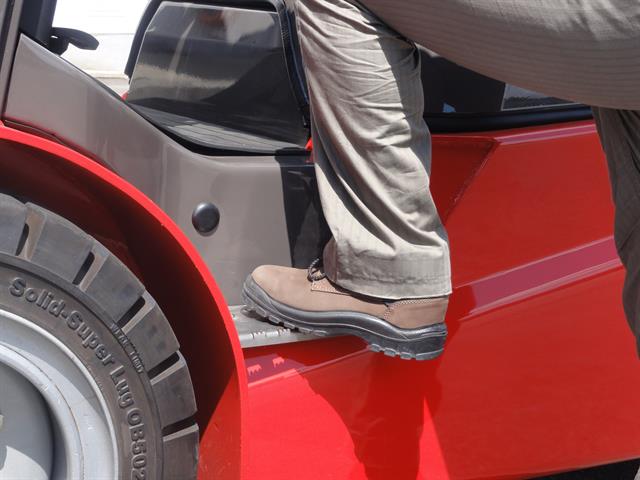 Stuart Taylor |
Stuart Taylor is Managing Director of Mentor FLT Training Limited, the UK's leading provider of training and associated services for all types of materials handling equipment and workplace transport.
Analysis of Reporting of Injuries, Diseases and Dangerous Occurrences Regulations (RIDDOR) reports shows that despite it being a seemingly straightforward process, a worrying number of incidents involving forklifts occur when the operator is entering or exiting the truck.
So how can you reduce risk in this fundamental area to improve forklift safety for all, ensure compliance and avoid costly accidents? As a start, we've highlighted some key hazards and suggested practical solutions for each case.
1.
Mounting and dismounting incorrectlyForklift operators can become complacent when mounting and dismounting a truck simply because they do it so often. But taking shortcuts is a sign that operators don't fully appreciate the risks and their consequences.
Forklift steps are cut relatively small and the most wear occurs at the spot where the operator's boot rotates over the step's edge, meaning it's most slippery where there is the greatest demand for friction.
A simple rule to reduce the risk of slips and falls is to maintain three points of contact when entering or exiting a truck. Facing the stationary truck and using handgrips and steps provided, operators should keep either one hand and two feet, or two hands and one foot, on the truck at all times, until they are in their seat or standing firmly on the ground, looking all around for hazards as they do so.
2.
Exiting the truck into the vicinity of a vehicle or loadOperators may be tempted to make a quick exit by jumping from the cab, but this puts them at a greater distance from the truck - and potentially into the path of another vehicle, very suddenly. By maintaining three points of contact, and facing towards the vehicle as they dismount, they can soon pull themselves back into the cab and out of danger. Jumping also puts stress on the knees and back which can affect mobility, or lead to broken bones.
It's not just passing vehicles that can pose a risk: shifting loads are a significant hazard. Sadly, many injuries occur when someone in the vicinity tries to manually steady an unstable load.
Operators exiting their truck to steady either their own or another load are in danger of serious harm, from pinch/crush injuries when putting their hands into a moving operation, to far worse consequences should the load become unstable and fall.
If a load becomes unstable or needs to be adjusted in transit, operators should place it on the ground, withdraw the forks and make the truck safe, before dismounting and carrying out any adjustments to secure the load.
If the unstable load is in the racking, the area should be cordoned off and the manager or supervisor informed immediately so that the risk can be dealt with before it can cause harm to someone in the vicinity.
 It is important to maintain three points of contact |
3.
Operating the controls from outside the truckMost modern forklifts are now fitted with a weight-operated micro-switch, which is activated by an operator sitting on the seat, to allow the controls to function. However, when this isn't the case, operators may be tempted to?access?the controls from outside the truck.
Doing so immediately puts the operator, and those working around them, in a position of danger. To reduce the risk, operators should
never operate the controls from anywhere but seated inside the cab. Operating from outside the cab not only requires them to stand next to an operating mast where they could be hit by the load, but they will also have an obstructed view, and a higher risk of running themselves (or someone else) over, as their handling of controls may not be as precise.
4.
Leaning outside the cabOperators should never lean or reach outside of the cab, as this puts them at risk of contact with passing obstructions/vehicles. Rather than reach out to access something, they should stop their truck in a suitable place, make the truck safe, dismount, and then access it on foot. If the load is obstructing the operator's view, and they need to lean out of the cab to see in front of them, they should be driving in reverse, giving themselves a clear view of their route and any upcoming hazards.
5.
Unintended control activationThis can be caused by controls becoming caught on the sleeves of clothing or by the operator leaning over to be handed or retrieve something, but, most commonly it is caused by the operator exiting the truck on the wrong side and accidentally touching the controls. What's more, some functions such as mast tilt, fork lowering or reach extension are gravity fed, which means they can be accidentally operated even when the power is switched off. Ensuring that operators exit on the correct side of the truck will reduce the risk of this happening. This side will be fitted with appropriate handles to aid them.
All these fundamental safety principles should be covered during your operators' basic forklift training course. However, as with your site rules or procedures, they're only effective if they are constantly enforced.
To successfully implement best practice, make sure your staff are motivated, trained and receive regular monitoring by managers and supervisors to ensure safe operation sticks, for the long term.